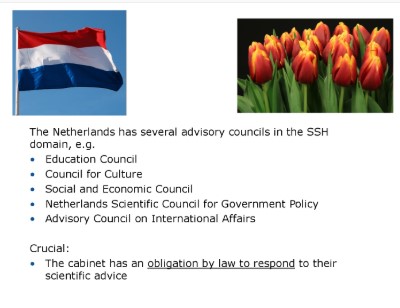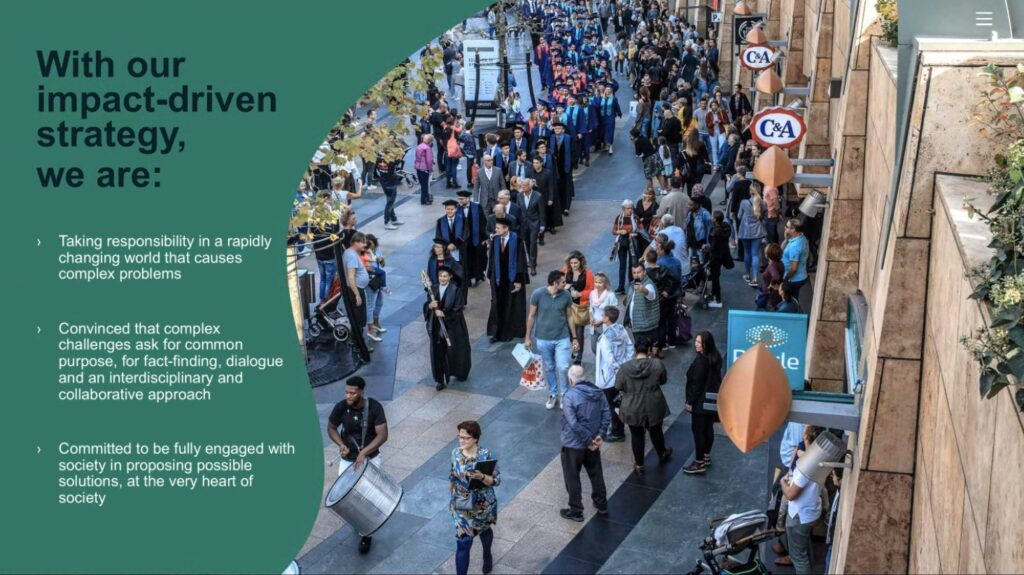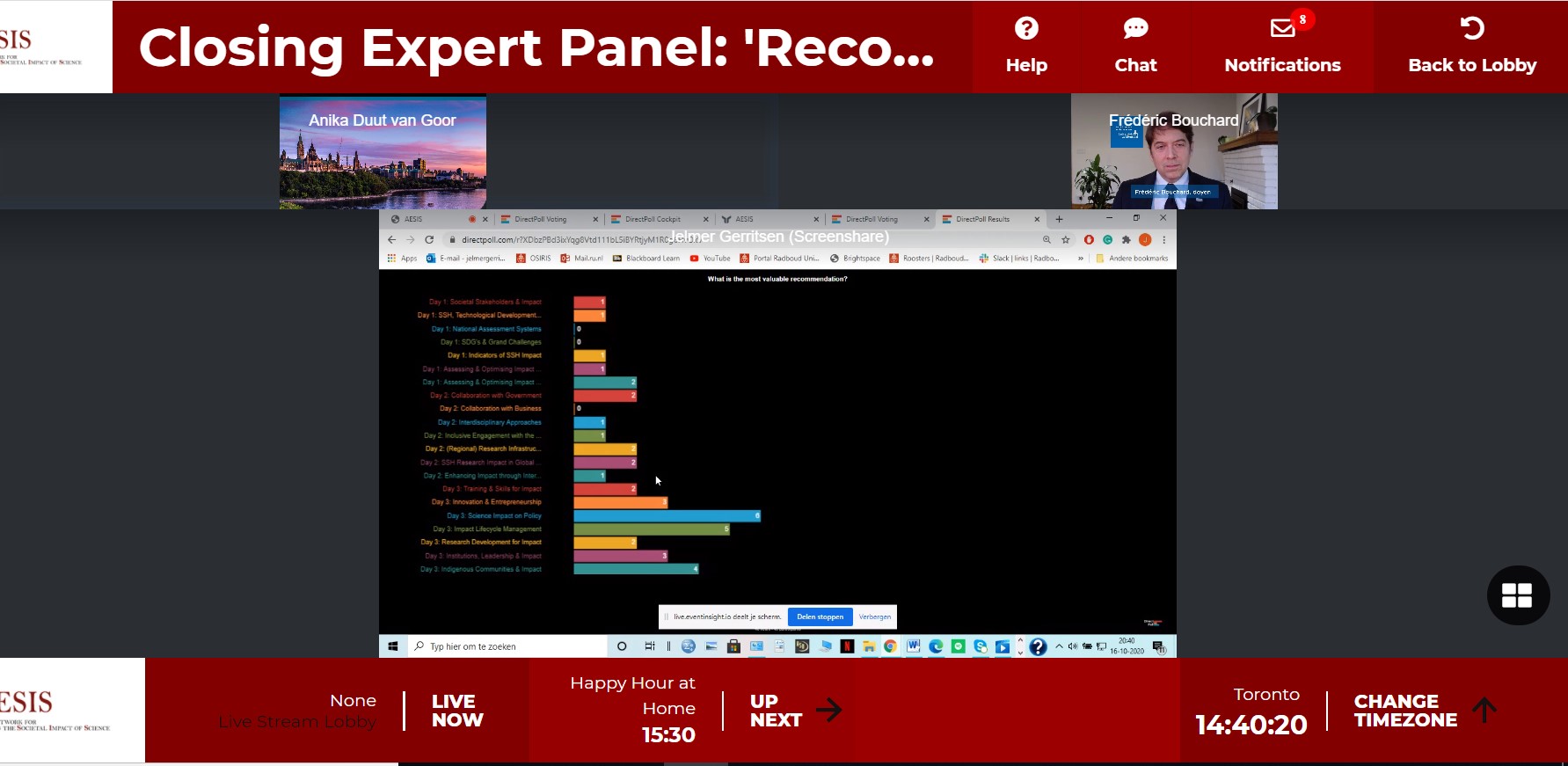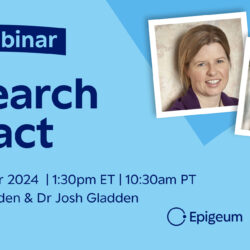Live Blogging Virtual Conference on Social Science’s Societal Impact
The Network for Advancing and Evaluating Societal Impact of Science, or AESIS, is currently conducting its Impact of Social Sciences and Humanities on Society conference series through Friday. The meeting, which was pre-COVID scheduled to be held in person in Ontario, Canada, will be conducted virtually (albeit from Ottawa).
The AESIS Network is a collection of individual members that include evaluators, policymakers, research councils, funders, knowledge exchange experts, and “other stakeholders of societal impact of science.” The network is managed by the Netherlands-based ScienceWorks.
Social Science Space is reporting on the conference with posts drawn from its sessions and events presented here in episodic form.
Opening Session: One Goal, Many Approaches
A plenary on policies for impact, featuring representatives from Canada, the European Union and South Africa discussing their localities’ approaches, opened the AESIS virtual conference. Those speakers – Mona Nemer, chief science advisor to the Government of Canada; Ted Hewitt, president of Canada’s federal funding agency the Social Sciences and Humanities Research Council; Pearl Dykstra, deputy chair of the European Union’s group of chief science advisors; and Crain Soudien chief executive officer of South Africa’s Human Sciences Research Office – telegraphed by their presence that there is no one-size-fits-all approach to demonstrating impact to policymakers and the public.

Dystra’s opening comments made this diversity explicit. The sociologist noted three different approaches about how governments interface with scientists at the highest levels. In countries with an Anglo-Saxon heritage, a single top science advisor to the chief executive is the norm. Western European countries tend to have a range of science advisors. And most countries, she concluded, have no official science advisor apart from the academies of science some have.
In the Netherlands, she continued, the Dutch cabinet has an obligation, by law, to respond to this advice offered by its range of science agencies, whether that advice was solicited or unsolicited. (She added that a recent attempt to get rid of this requirements to respond failed.) If the cabinet chooses not to follow the science advice, they have to make that rejection crystal clear.
Indicators of SSH Impact session
Day 1 of the AESIS Conference culminated in seven parallel sessions series covering a range of topics such as measuring the impact of the social sciences and humanities, to understanding how social science and humanities (SSH) could impact big data, AI, and Grand Challenges. The Indicators of SSH Impact session specifically focused on building more reliable and feasible metrics for evaluation of social impact by SSH research. Session chair Kate Geddie of CIFAR and panelists Kara Scally-Irvine of KSI Consulting and Vera Hazelwood of Researchfish detailed the importance of metadata and potential for deeper, more impactful data findings on evaluating societal impact, while interrogating the effectiveness of the question of building reliable and feasible metrics.
Geddie began the breakout session by acknowledging the difficulty of data collection and interpretation. She posed the question of whether or not it is possible to build a better metric. With regards to her organization CIFAR, she stated the need for CIFAR’s model to pursue that question, with what the panelists stated is a multitude of data and metadata available. Moreover, there is a breadth of technology that researchers can use to understand such data and further their understanding of research systems across disciplines.
However, as Scally-Irvine emphasized, researchers must remember why this information is important, and acknowledge the human value judgement inherent to what measures and metrics we privilege for results. Understanding that metrics stem from particular ways of thinking and perspectives, perhaps we can utilize resources in relation to the fact that they are culturally embedded. This may also help us to better understand knowledge for impact. Moreover, what are the potential ways that researchers can get the most out of their strategies and research? As Hazelwood stated, stakeholders invested in research are increasingly interested and supportive of the impact that can be derived from research. As such, it is important that researches leverage the information from a multitude of sources, analyze ways to improve the impact of their data and strategies, and improve relationships with funders. Fortunately, SSH researchers have high rates of engagement and collaboration with their audiences.
Furthering collaboration and interaction with funding bodies, the public, and policy officials can not only help integrate the social sciences and humanities with societal issues, but also improve the impact of SSH research and data.
-Kenalyn Ang
Day 2: Exploring New Pathways to Impact
The second day of the AESIS conference opened with a wide-ranging set of talks that examined how various institutions create or enhance impact under their own roofs. These were offered as models, but as Rutger Engels, the rector magnificus of Erasmus University Rotterdam noted, these efforts require an institution to shift it strategy, focus and it human resources to meet these goals.

At his university, for example, the entire institution is focused on creating positive societal impact, both at the societal level but also at the individual level. That focus is espoused in a mission statement Engels shared, “Think as a scientist. Act as an entrepreneur. Care as a citizen,” which boils down to the tagline of “Making Minds Matter.”
Social science and humanities (SSH) research projects have impactful outcomes and uses for businesses, but how do we bridge the research and commercial and business sectors? This was what Susan Morris, Mikkel Rasmussen, and Jeffrey Ollinger discussed at one of Day 2’s parallel sessions. Morris, Natural Sciences and Engineering Research Council of Canada representative and chair, moderated the discussion and raised important questions such as how can we promote SSH students to companies and businesses?
Ollinger showcased how big businesses and companies could incorporate SSH graduates in their offices. Discussing the Royal Bank of Canada’s own recruitment journey from an HR point of view, Ollinger, the bank’s senior manager of early talent acquisition, began his presentation by stating that students, educators and employers are not on the same page when it comes to viewing whether students are ready for the workforce or not. He emphasized that the foundational skills to job success were rooted in the SSH. These include empathy, effective communication, collaboration and analytical thinking. Moreover, Ollinger highlighted the importance of engaging with students, who often change their minds and future plans throughout their university careers. Encouraging students to be open to ideas, all the while reminding the commercial sector that many of their problems are human behavior problems, can continue to help bridge collaboration between SSH and businesses.
Rasmussen, director and founder of the Denmark-based consulting firm ReD Associates, effectively summarized this notion that human behavior problems are often the root of business problems by stating that all big business decisions are bets on human behavior. He acknowledged the increased use of algorithms to understand human contexts, which in turn, addresses the crucial question of what a human context is? What is a human being? These are both social problems that businesses must try to understand through the work done by social scientists and humanities graduates. In fact, it is what Rasmussen and his colleagues work towards everyday at ReD Associates. Through his professional experiences, he walked session attendees through some findings that indicate human science methods can indeed help understand the ‘why’ behind business challenges, in particular through deep understanding of how companies and people in real contexts experience and interpret the world. Considering the ‘how’ and ‘what’ behind consumer actions, as well as the ‘where’ and ‘when behind product purchases is only one side of the coin. We must also remember that humans, businesses and societal entities are defined by the world, rarely acting as we intend or imagine.
-Kenalyn Ang
Day 3: Connecting Research with the Broader Community
The fourth annual AESIS Conference on the Impact of Social Sciences and Humanities concluded with a series of excellent recommendations to ensure that the social and behavioral sciences and humanities are included in today’s policy making, scientific research and overall social impact. The day began with a talk on the public value of social science in the COVID-19 era, led by Arthur Lupia. He emphasized the importance of gratitude, community and health and underlined three projects or experiments that the NSF have conducted today to help build a pipeline at a bigger scale for social scientists to have greater impact. Mike DeGagné and Karina Batthyány followed up, with DeGagné pointing out the hunger people have today for a baseline of truth and how SSH can develop public policies to address world issues like climate change and protecting democracy. The day’s parallel sessions focused on stimulating impact of SSH, through training and skills, innovation and entrepreneurship, science impact and policy, impact lifecycle management, research development, institutions and leadership and finally indigenous communities. Researchers and panelists discussed several important issues facing social scientists, such as the need to consider the mission, strategy and design of research projects, awareness of who controls the knowledge production and dissemination of data, particularly with indigenous communities, and the need to train the next generation of students to find ways to integrate collaborative skills training and research training. The panelists also acknowledged the improvements that have been made within the social sciences. There are many opportunities for innovation in the SSH sector, and improvements have been made over the years with regards to organizing collaboration on global challenges and incorporating diverse skills and knowledges to enhance research impact. While many of the recommendations made were not surprising, as Frédéric Bouchard noted, it is the implementation of research and recent developments that have changed in the last 5 to 10 years. How we communicate the value of SSH and demonstrate the relevance of social sciences are no longer the questions. Rather, social scientists are asking how to make collaboration happen, how to ensure research is more impactful, and how to make a more collective social impact between the SSH and STEM. As the SSH industry looks long-term at their work ahead, social, behavioral and economic scientists can appreciate the work that has been done while strategizing ways to include their findings and research in meaningful projects and work separate from just their publications.
– Kenalyn Ang
About the Conference
The last iteration of the series took place in the European cities of Cardiff and Copenhagen and later in Washington, D.C. In bringing the session to Canada, organizers note the country’s success in promoting its “research intensity” to a global audience. “The three granting councils [Social Science and Humanities (SSHRC); Natural Science and Engineering; and Canadian Institutes of Health Research], alongside other organisations and universities, have been aiming to evaluate (funded) performance on not only academic impact, but also on indicators addressing future challenges, the engagement of indigenous communities, and attention for equity, diversity, and inclusion.”
A number of Canadian organizations, including SSHRC, Research Impact Canada, York and Ryerson universities, and the Federation for the Humanities and Social Sciences are partners of the conference, as are some private enterprises like SAGE Publishing, the parent of Social Science Space.
The program committee is similarly broad, with McMaster University philosopher Sandra Lapointe; David Phipps, executive director of research and innovation Services at York; Amy Cook, senior director of knowledge mobilization for CIFAR; Susan Morris, director of the Natural Sciences and Engineering Research Council; Tim Wilson, executive director of research grants & partnerships for SSHRC; Steven Liss, vice-president research and innovation at Ryerson; and Gabriel Miller, president of the Federation for the Humanities and Social Sciences.
























































































